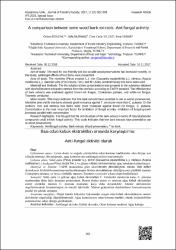| dc.contributor.author | Özgenç, Özlem | |
| dc.contributor.author | Durmaz, Sefa | |
| dc.contributor.author | Yıldız, Ümit Cafer | |
| dc.contributor.author | Erişir, Emir | |
| dc.date.accessioned | 2020-11-20T14:54:00Z | |
| dc.date.available | 2020-11-20T14:54:00Z | |
| dc.date.issued | 2017 | |
| dc.identifier.issn | 1303-2399 | |
| dc.identifier.uri | https://doi.org/10.17475/kastorman.282637 | |
| dc.identifier.uri | https://hdl.handle.net/20.500.12809/2090 | |
| dc.description | WOS: 000425843500016 | en_US |
| dc.description.abstract | Aim of study: The need for eco-friendly and bio-soluble wood preservatives has increased recently. In this study, antifungal effects of tree barks were researched. Area of study: The maritime (Pinus pinaster L.), iron (Casuarina equisetifolia L.), mimosa (Acacia mollissima L.), calabrian pine (Pinus brutia Ten.), and fir (Abies nordmanniana) tree barks were used. Material and Methods: The the solution at two concentrations was prepared to the substance obtained with alcohol benzene extraction method from the tree bark according to TAPPI standard. The effectiveness of bark extracts was evaluated against brown-rot fungus; Coniophera puteana, and white-rot fungus; Trametes versicolor. Main results: This study indicates that tree bark extracts have potential to use as wood preservatives. Maritime pine and fir tree barks showed good resistance against T. versicolor more than C. puteana. On the contrary, iron and mimosa tree barks were more resistance against brown-rot fungus, C. puteana. Concentration is the most important factor for inhibition of fungal activity. Inhibition of fungal growth increased parallel with concentration. Research highlights: It is thought that the rich structure of the bark extract in terms of natural phenolic compounds could inhibit fungal activity. This study indicates that tree bark extracts have potential to use as wood preservatives. | en_US |
| dc.description.sponsorship | Karadeniz Technical University, Research Fund [FHD-2015-5190] | en_US |
| dc.description.sponsorship | The authors would like to thank Karadeniz Technical University, Research Fund (Project No: FHD-2015-5190), in Turkey provided for support. This study was presented at International Forestry Symposium on 03-06 October 2016, Kastamonu, Turkey. | en_US |
| dc.item-language.iso | eng | en_US |
| dc.publisher | Kastamonu Univ, Orman Fak | en_US |
| dc.item-rights | info:eu-repo/semantics/openAccess | en_US |
| dc.subject | Antifungal Activity | en_US |
| dc.subject | Bark Extract | en_US |
| dc.subject | Wood Preservation | en_US |
| dc.subject | Tree Bark | en_US |
| dc.title | A comparison between some wood bark extracts: Antifungal activity | en_US |
| dc.item-type | article | en_US |
| dc.contributor.department | MÜ, Kavaklıdere Şehit Mustafa Alper Meslek Yüksekokulu, Ormancılık Bölümü | en_US |
| dc.contributor.institutionauthor | Durmaz, Sefa | |
| dc.identifier.doi | 10.17475/kastorman.282637 | |
| dc.identifier.volume | 17 | en_US |
| dc.identifier.issue | 3 | en_US |
| dc.identifier.startpage | 502 | en_US |
| dc.identifier.endpage | 508 | en_US |
| dc.relation.journal | Kastamonu University Journal of Forestry Faculty | en_US |
| dc.relation.publicationcategory | Makale - Uluslararası Hakemli Dergi - Kurum Öğretim Elemanı | en_US |


















